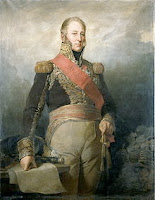FRENCH MARSHAL
Edouard
Adolphe Casimir Joseph Mortier
Born: 1768 LeCateau-Cambresis, France
Died: 1835 Paris,
France
Rank: Marshal of
France
Edouard Mortier was born at the Le Cateau-Cambresis on 13thFebruary
1768, son of Charles Mortier and mother Marie Anne Joseph Bonnaire and at the
age of 23 Mortier entered the army as a sub-lieutenant in 1791 after his job as
a clerk to a merchant at Dunkirk. There he learned the Spanish language, and behaved remarkably
well.
He served in the French Revolutionary Wars in the campaigns
of 1792 and 1793 on the north-eastern frontier and in the Netherlands and on
the Meuse and the Rhine.
In the war against the Second Coalition in 1799, he was
promoted successively general of brigade to general of division. During the
Second Battle of Zurich, Mortier led a force of 8000 troops in the attack from
Dieticon on Zurich. His conduct of the French occupation of Hanover, bringing
about the Convention of Artlenburg, led Napoleon to include Mortier in the
first list of marshals created in 1804.
Mortier commanded a corps of the Grande Armee in the Ulm campaign in which he distinguished himself. In the campaign of the middle Danube in the
battle of Austerliz, Napoleon placed him in command of a newly-formed VIII
Corps. He over-extended his line of march on the north shore of the Danube and
failed to take napoleon’s advice to protect his north flank. A combined force
of Russian and Austrians, under over-all command of Mikhail Kutuzov enticed
Mortier to send his 2nd Division into a trap where the French troops
were caught in a valley between two Russian columns. They were rescued by the
timely arrival of a second division, under commend of Pierre Dupont de
L’Etang’s 1st Division, which covered a day’s march in half a day.
On November 11th in 1805 the Battle of
Durrenstein fought well into the night. Both sides claimed a victory, the
French lost more than a third of the participants, while Gazan’s division had
over 40% losses. The Austrians and Russians also had heavy losses, close to
16%. After Austerliz, Napoleon dispersed the Corps and Gazan received the
Legion of Honor, but Mortier was simply reassigned to a new position.
In 1806 Mortier was serving in Hanover and north-western
Germany. In 1807 he then again served with the Grande Armee in the Friedland
campaign, in the siege of both Stralsund and Kolberg.
In 1808, Napoleon created him Duke of Trevise in his own
Kingdom of Italy, and shortly after he commended and army corps in Napoleon’s
campaign for the recapture of Madrid.
Mortier remained in Spain for two campaigns, winning the
victory of Ocana in November 1809. In 1812 and 1813 he commanded the Imperial
Guard, and in the defensive campaigns of 1814 he rendered brilliant services in
command of rearguards and covering detachments.
In 1815, after the flight of the Bourbon King Louis XVIII
of France, he rejoined Napoleon during the 100 days and was given commend of
the Imperial Guard once more. But at the opening of the Battle of Waterloo he
was unable to continue his duties due to severe sciatica.
After the second Bourbon Restoration he was for the first
time in disgrace, but then in 1819 he was readmitted to the Chamber of Peers
and in 1825 received the Order of the Holy Spirit, the Kingdom’s highest.
In 1830-31 he was Ambassador of France to Russia at St
Petersburg, and in 1834-35 minster of war and president of the council of
ministers.
It was on the 28th July 1835 in Paris while accompanying
Louis-Philippe and his three sons to a review of the National Guard, a machine consisted of
twenty-five barrels, charged with various species of missiles, which were fired
simultaneously by a train of gunpowder with intent to destroy the French king. The king and his
sons escaped but Marshal Mortier, was shot dead, and many more were dangerously
wounded. Such were the circumstances under which one of after escaping the perils of
the battle-field, perished in a time of peace, in the streets of the capital. It is said that the king bitterly mourned him, and wept
openly at the marshal’s funeral.
Mortier was Married to Eve Anne Hymmes on 26 January 1799 and is said that they had seven children.









































